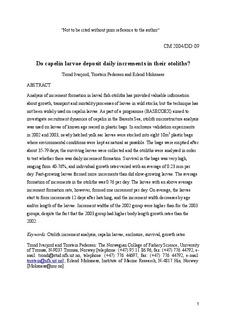Do capelin larvae deposit daily increments in their otoliths?
Working paper

Åpne
Permanent lenke
http://hdl.handle.net/11250/100611Utgivelsesdato
2004Metadata
Vis full innførselSamlinger
Sammendrag
Analysis of increment formation in larval fish otoliths has provided valuable information
about growth, transport and mortality processes of larvae in wild stocks, but the technique has
not been widely used on capelin larvae. As part of a programme (BASECOEX) aimed to
investigate recruitment dynamics of capelin in the Barents Sea, otolith microstructure analysis
was used on larvae of known age reared in plastic bags. In enclosure validation experiments
in 2002 and 2003, newly hatched yolk sac larvae were stocked into eight 10m3 plastic bags
where environmental conditions were kept as natural as possible. The bags were emptied after
about 35-79 days, the surviving larvae were collected and the otoliths were analysed in order
to test whether there was daily increment formation. Survival in the bags was very high,
ranging from 40-76%, and individual growth rates varied with an average of 0.23 mm per
day. Fast-growing larvae formed more increments than did slow-growing larvae. The average
formation of increments in the otoliths was 0.76 per day. The larvae with an above average
increment formation rate, however, formed one increment per day. On average, the larvae
start to form increments 12 days after hatching, and the increment width decreases by age
and/or length of the larvae. Increment widths of the 2002 group were higher than for the 2003
groups, despite the fact that the 2003 group had higher body length growth rates than the
2002.
Utgiver
ICESSerie
ICES CM documents2004/DD:09